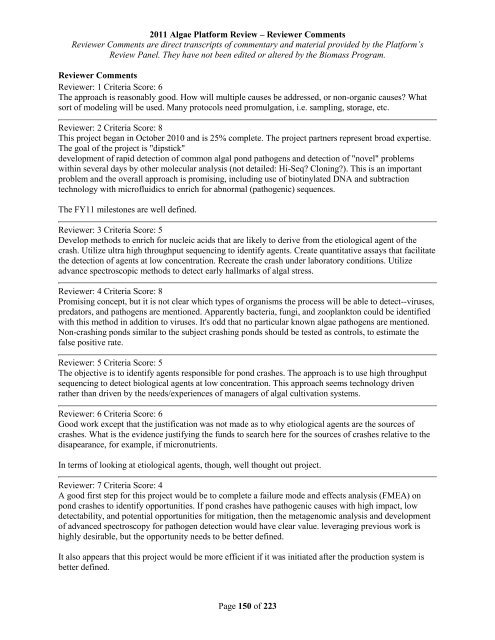Reviewer Comments - EERE
Reviewer Comments - EERE
Reviewer Comments - EERE
Create successful ePaper yourself
Turn your PDF publications into a flip-book with our unique Google optimized e-Paper software.
2011 Algae Platform Review – <strong>Reviewer</strong> <strong>Comments</strong><br />
<strong>Reviewer</strong> <strong>Comments</strong> are direct transcripts of commentary and material provided by the Platform’s<br />
Review Panel. They have not been edited or altered by the Biomass Program.<br />
<strong>Reviewer</strong> <strong>Comments</strong><br />
<strong>Reviewer</strong>: 1 Criteria Score: 6<br />
The approach is reasonably good. How will multiple causes be addressed, or non-organic causes? What<br />
sort of modeling will be used. Many protocols need promulgation, i.e. sampling, storage, etc.<br />
<strong>Reviewer</strong>: 2 Criteria Score: 8<br />
This project began in October 2010 and is 25% complete. The project partners represent broad expertise.<br />
The goal of the project is "dipstick"<br />
development of rapid detection of common algal pond pathogens and detection of "novel" problems<br />
within several days by other molecular analysis (not detailed: Hi-Seq? Cloning?). This is an important<br />
problem and the overall approach is promising, including use of biotinylated DNA and subtraction<br />
technology with microfluidics to enrich for abnormal (pathogenic) sequences.<br />
The FY11 milestones are well defined.<br />
<strong>Reviewer</strong>: 3 Criteria Score: 5<br />
Develop methods to enrich for nucleic acids that are likely to derive from the etiological agent of the<br />
crash. Utilize ultra high throughput sequencing to identify agents. Create quantitative assays that facilitate<br />
the detection of agents at low concentration. Recreate the crash under laboratory conditions. Utilize<br />
advance spectroscopic methods to detect early hallmarks of algal stress.<br />
<strong>Reviewer</strong>: 4 Criteria Score: 8<br />
Promising concept, but it is not clear which types of organisms the process will be able to detect--viruses,<br />
predators, and pathogens are mentioned. Apparently bacteria, fungi, and zooplankton could be identified<br />
with this method in addition to viruses. It's odd that no particular known algae pathogens are mentioned.<br />
Non-crashing ponds similar to the subject crashing ponds should be tested as controls, to estimate the<br />
false positive rate.<br />
<strong>Reviewer</strong>: 5 Criteria Score: 5<br />
The objective is to identify agents responsible for pond crashes. The approach is to use high throughput<br />
sequencing to detect biological agents at low concentration. This approach seems technology driven<br />
rather than driven by the needs/experiences of managers of algal cultivation systems.<br />
<strong>Reviewer</strong>: 6 Criteria Score: 6<br />
Good work except that the justification was not made as to why etiological agents are the sources of<br />
crashes. What is the evidence justifying the funds to search here for the sources of crashes relative to the<br />
disapearance, for example, if micronutrients.<br />
In terms of looking at etiological agents, though, well thought out project.<br />
<strong>Reviewer</strong>: 7 Criteria Score: 4<br />
A good first step for this project would be to complete a failure mode and effects analysis (FMEA) on<br />
pond crashes to identify opportunities. If pond crashes have pathogenic causes with high impact, low<br />
detectability, and potential opportunities for mitigation, then the metagenomic analysis and development<br />
of advanced spectroscopy for pathogen detection would have clear value. leveraging previous work is<br />
highly desirable, but the opportunity needs to be better defined.<br />
It also appears that this project would be more efficient if it was initiated after the production system is<br />
better defined.<br />
Page 150 of 223




